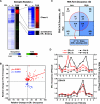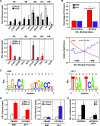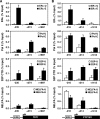Genomic analyses of transcription factor binding, histone acetylation, and gene expression reveal mechanistically distinct classes of estrogen-regulated promoters
- PMID: 17515612
- PMCID: PMC1951957
- DOI: 10.1128/MCB.00083-07
Genomic analyses of transcription factor binding, histone acetylation, and gene expression reveal mechanistically distinct classes of estrogen-regulated promoters
Abstract
To explore the global mechanisms of estrogen-regulated transcription, we used chromatin immunoprecipitation coupled with DNA microarrays to determine the localization of RNA polymerase II (Pol II), estrogen receptor alpha (ERalpha), steroid receptor coactivator proteins (SRC), and acetylated histones H3/H4 (AcH) at estrogen-regulated promoters in MCF-7 cells with or without estradiol (E2) treatment. In addition, we correlated factor occupancy with gene expression and the presence of transcription factor binding elements. Using this integrative approach, we defined a set of 58 direct E2 target genes based on E2-regulated Pol II occupancy and classified their promoters based on factor binding, histone modification, and transcriptional output. Many of these direct E2 target genes exhibit interesting modes of regulation and biological activities, some of which may be relevant to the onset and proliferation of breast cancers. Our studies indicate that about one-third of these direct E2 target genes contain promoter-proximal ERalpha-binding sites, which is considerably more than previous estimates. Some of these genes represent possible novel targets for regulation through the ERalpha/AP-1 tethering pathway. Our studies have also revealed several previously uncharacterized global features of E2-regulated gene expression, including strong positive correlations between Pol II occupancy and AcH levels, as well as between the E2-dependent recruitment of ERalpha and SRC at the promoters of E2-stimulated genes. Furthermore, our studies have revealed new mechanistic insights into E2-regulated gene expression, including the absence of SRC binding at E2-repressed genes and the presence of constitutively bound, promoter-proximally paused Pol IIs at some E2-regulated promoters. These mechanistic insights are likely to be relevant for understanding gene regulation by a wide variety of nuclear receptors.
Figures







Similar articles
-
Transcription factor accessibility and histone acetylation of the progesterone receptor gene differs between parental MCF-7 cells and a subline that has lost progesterone receptor expression.Gene. 2004 Mar 17;328:143-51. doi: 10.1016/j.gene.2003.12.003. Gene. 2004. PMID: 15019994
-
From the Cover: Location analysis of estrogen receptor alpha target promoters reveals that FOXA1 defines a domain of the estrogen response.Proc Natl Acad Sci U S A. 2005 Aug 16;102(33):11651-6. doi: 10.1073/pnas.0505575102. Epub 2005 Aug 8. Proc Natl Acad Sci U S A. 2005. PMID: 16087863 Free PMC article.
-
Aryl hydrocarbon receptor-mediated transcription: ligand-dependent recruitment of estrogen receptor alpha to 2,3,7,8-tetrachlorodibenzo-p-dioxin-responsive promoters.Mol Cell Biol. 2005 Jul;25(13):5317-28. doi: 10.1128/MCB.25.13.5317-5328.2005. Mol Cell Biol. 2005. PMID: 15964790 Free PMC article.
-
A global view of transcriptional regulation by nuclear receptors: gene expression, factor localization, and DNA sequence analysis.Nucl Recept Signal. 2008 Feb 15;6:e005. doi: 10.1621/nrs.06005. Nucl Recept Signal. 2008. PMID: 18301785 Free PMC article. Review.
-
"Promoter array" studies identify cohorts of genes directly regulated by methylation, copy number change, or transcription factor binding in human cancer cells.Ann N Y Acad Sci. 2005 Nov;1058:162-85. doi: 10.1196/annals.1359.024. Ann N Y Acad Sci. 2005. PMID: 16394135 Review.
Cited by
-
Compensatory Estrogen Signal Is Capable of DNA Repair in Antiestrogen-Responsive Cancer Cells via Activating Mutations.J Oncol. 2020 Jul 28;2020:5418365. doi: 10.1155/2020/5418365. eCollection 2020. J Oncol. 2020. PMID: 32774370 Free PMC article. Review.
-
TNFα signaling exposes latent estrogen receptor binding sites to alter the breast cancer cell transcriptome.Mol Cell. 2015 Apr 2;58(1):21-34. doi: 10.1016/j.molcel.2015.02.001. Epub 2015 Mar 5. Mol Cell. 2015. PMID: 25752574 Free PMC article.
-
Cell-specific integration of nuclear receptor function at the genome.Wiley Interdiscip Rev Syst Biol Med. 2013 Sep-Oct;5(5):615-29. doi: 10.1002/wsbm.1231. Epub 2013 Jun 11. Wiley Interdiscip Rev Syst Biol Med. 2013. PMID: 23757177 Free PMC article.
-
Histones and heart failure in diabetes.Cell Mol Life Sci. 2018 Sep;75(17):3193-3213. doi: 10.1007/s00018-018-2857-1. Epub 2018 Jun 22. Cell Mol Life Sci. 2018. PMID: 29934664 Free PMC article. Review.
-
Genomics of signaling crosstalk of estrogen receptor alpha in breast cancer cells.PLoS One. 2008 Mar 26;3(3):e1859. doi: 10.1371/journal.pone.0001859. PLoS One. 2008. PMID: 18365014 Free PMC article.
References
-
- Acevedo, M. L., K. C. Lee, J. D. Stender, B. S. Katzenellenbogen, and W. L. Kraus. 2004. Selective recognition of distinct classes of coactivators by a ligand-inducible activation domain. Mol. Cell 13:725-738. - PubMed
-
- Aiyar, S. E., J. L. Sun, A. L. Blair, C. A. Moskaluk, Y. Z. Lu, Q. N. Ye, Y. Yamaguchi, A. Mukherjee, D. M. Ren, H. Handa, and R. Li. 2004. Attenuation of estrogen receptor alpha-mediated transcription through estrogen-stimulated recruitment of a negative elongation factor. Genes Dev. 18:2134-2146. - PMC - PubMed
-
- Andrau, J. C., L. van de Pasch, P. Lijnzaad, T. Bijma, M. G. Koerkamp, J. van de Peppel, M. Werner, and F. C. Holstege. 2006. Genome-wide location of the coactivator mediator: binding without activation and transient Cdk8 interaction on DNA. Mol. Cell 22:179-192. - PubMed
-
- Blais, A., and B. D. Dynlacht. 2005. Constructing transcriptional regulatory networks. Genes Dev. 19:1499-1511. - PubMed
-
- Bodescot, M., and O. Brison. 1996. Characterization of new human c-myc mRNA species produced by alternative splicing. Gene 174:115-120. - PubMed
Publication types
MeSH terms
Substances
Grants and funding
LinkOut - more resources
Full Text Sources
Molecular Biology Databases
Miscellaneous
